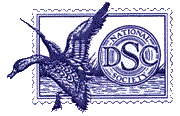Sanibel,
Florida Selected As Site for 2007 Federal Duck
Stamp Contest and 75th Anniversary Celebration
The nation’s oldest,
most prestigious art contest is coming to the J.N. “Ding” Darling National
Wildlife Refuge and Sanibel, Florida, where artwork will be chosen for the 75th Federal
Duck Stamp.
The U.S. Fish and Wildlife Service announced today the contest would be held at BIG ARTS
cultural center in Sanibel October 12-13, 2007 to honor Darling, the nationally known
cartoonist and conservationist who designed
the first Federal Duck Stamp in 1934. The
Migratory Bird Hunting and Conservation Stamp,
affectionately also known as the “Duck Stamp,” was created by Darling as the federal tax required for
hunting migratory
waterfowl.
“We are excited to bring the Federal
Duck Stamp Contest to Sanibel and “Ding” Darling Refuge,” said Dale Hall,
Director of the U.S. Fish and Wildlife Service. “I can think of no better place to
honor “Ding” with the
selection of artwork for America’s 75th
Federal Duck Stamp.”
Today, the $15 stamp is the cornerstone of
one of the world’s most successful
conservation programs. Money from Duck Stamp sales is a vital tool for wetland
conservation, with investing 98 cents of every dollar generated
going to purchase or lease wetland habitat for the National Wildlife
Refuge System. Since the stamp’s inception, nearly $700 million has been raised to acquire more than 5.2 million
acres of habitat and hundreds of refuges
across the Nation to conserve America’s fish and wildlife
resources.
The winning artwork selected at the 2007
contest will grace the 2008-2009 Federal Duck
Stamp, which will be the program’s 75th stamp. It will be available for sale in summer, 2008.
“As we select the art to appear on the
75th stamp, it is an opportunity to remind the
American public how important these stamp funds are for wildlife conservation,” said
Hall. “In addition to the migratory waterfowl hunters who purchase the stamps, we
want to encourage all birders, bird-watchers
and other wildlife nature enthusiasts to purchase the duck stamps to help conserve
wildlife and habitat throughout the country.”
From Darling’s first design in 1934
through the 1949 stamp, the U.S. Fish and
Wildlife Service appointed an artist to create the stamp. But in 1950, the Service started an annual juried contest
to select the artwork
to grace the front of the stamp. Since that
time, a panel of five judges with expertise in
waterfowl, stamp design and artistic detail have been chosen for each year’s contest.
Today, the Federal Duck Stamp is the only
U.S. stamp whose design is chosen through a federally sponsored art competition. Hundreds
of prominent wildlife artists from across the country enter each year, with the winning
design appearing on the following year’s stamp. While the winner receives no money
from the federal government, the winning artist can expect to earn hundreds of thousands
of dollars benefits from the increased visibility and sale of their prints and artwork.
“We’re excited to host such an
important national contest,” said Rob Jess, manager
of the 6,400-acre Ding Darling National Wildlife Refuge that hosts more than 800,000 visitors annually.
“Part of our mission is to
celebrate “Ding’s” legacy.
When he created the first duck stamp, I wonder if
he knew what a tremendous influence he would have on conservation in this country.”
“This is a great opportunity for the
area to showcase its wonderful nature, where visitors can experience exceptional wildlife
viewing,” said D.T. Minich, executive director of the Lee County Visitor &
Convention Bureau. “Sanibel Island with its “Ding” Darling National
Wildlife Refuge is such a fabulous example of the J.N. “Ding” Darling’s
conservation legacy.”
J.N. “Ding” Darling National Wildlife Refuge was created when President Harry
Truman signed an Executive Order in 1945 to create Sanibel National Wildlife Refuge. It
was established as a result of a campaign led by “Ding” Darling himself to
protect this special place. Darling lived near the refuge on Captiva Island. He first came
to the area in 1934, shortly after he had created the first Migratory Bird Conservation
Stamp. He became a winter resident in the late 1930s, and resided on the island for two
decades. In 1967, the refuge was renamed J.N. “Ding” Darling NWR after the man
that worked so hard to protect it.
In 2005, more than 1.6 million people
purchased a Federal Duck Stamp. Every waterfowl hunter over the age of 16 is required to
buy a Federal Duck Stamp in order to hunt waterfowl. In addition, Federal Duck Stamps are
highly sought after by collectors. Visitors to National Wildlife Refuges also purchase Duck Stamps, which not only supports
land acquisition for refuges, but also
provides free entry into any national wildlife refuge in the country that charges an
entrance fee.
The U.S. Fish and Wildlife Service is the
principal Federal agency responsible for
conserving, protecting and enhancing fish, wildlife and plants
and their habitats for the continuing benefit of the American people. The Service manages the 95-million-acre
National Wildlife Refuge System, which
encompasses 545 national wildlife refuges, thousands of small wetlands and other special
management areas. It also operates 69 national fish hatcheries, 64 fishery resources
offices and 81 ecological services field stations. The agency enforces federal wildlife
laws, administers the Endangered Species Act, manages migratory bird populations, restores
nationally significant fisheries, conserves and restores wildlife habitat such as
wetlands, and helps foreign and Native American tribal governments with their conservation
efforts. It also oversees the Federal Assistance program, which distributes hundreds of
millions of dollars in excise taxes on fishing and hunting equipment to state fish and
wildlife agencies.
Visit the Service’s website at http://www.fws.gov.
News releases are also available on the World Wide Web at
http://news.fws.gov
Questions concerning a particular news
release or item of information should be
directed to the person listed as the
contact. General comments or observations
concerning the content of the information
should be directed to Malcomb Barsella (malcomb_barsella@fws.gov)
in the Office of Public Affairs. |
